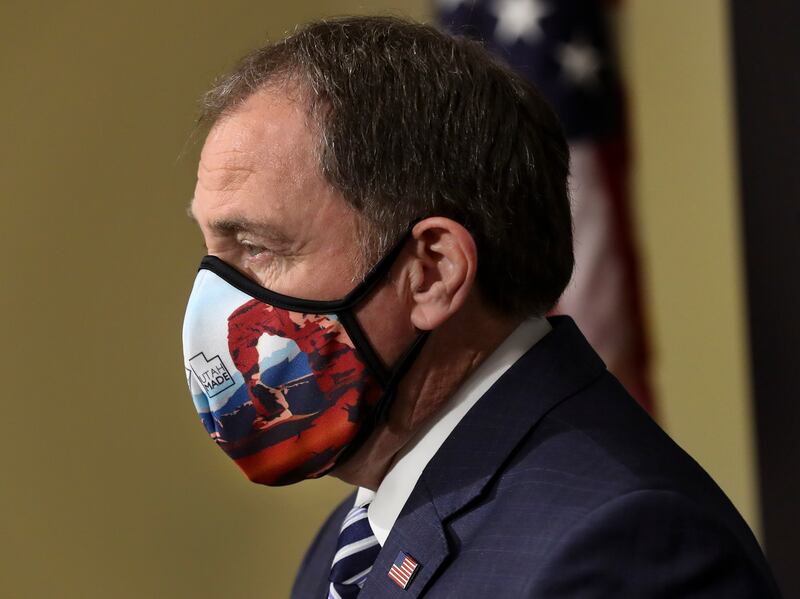SALT LAKE CITY — Utah’s COVID-19 risk level will officially move to “moderate” on Friday, allowing for some businesses to reopen, Gov. Gary Herbert announced Tuesday.
Under the Utah Leads Together 2.0 plan, which classifies each risk level by color, the state will move from the red, or high-risk phase, to the orange, or moderate phase.
Group gatherings of 20 or fewer will be allowed, Herbert said, up from 10. Businesses that had been ordered to close like gyms and salons will be able to reopen “if they in fact follow strict protocols and precautions,” Herbert said.
The change will also allow restaurants to open to dine-in services “if they follow appropriate protocol, making sure that there’s distancing requirements (followed),” Herbert said during Tuesday’s news conference.
A statewide ban on in-restaurant dining was put in place March 17. Salt Lake County made a similar order the day before. Several local health districts have ordered salons and other businesses that serve as public gathering places closed, but there was not a statewide closure of those businesses.
The state order will preempt county and health district orders, but local government officials in areas at lower or higher risk from the virus will be able to work with their health departments and the Utah Department of Health to determine if they can vary from the state guidelines, according to the governor.
Salt Lake County officials were reviewing Tuesday evening whether or not they will ask restaurants and other businesses to remain closed, said Chloe Morroni, spokeswoman for Salt Lake County Mayor Jenny Wilson’s office.
Salt Lake County has the highest number of cases and deaths in the state.

But Herbert cautioned that without continued vigilance, Utah could return to the high-risk level. Residents are still encouraged to work from home when possible, avoid large gatherings and wear face masks when in public.
Those at high risk still must be “extra cautious,” Herbert said.
Free masks will temporarily be available to Utahns through funding from Coronavirus Aid, Relief and Economic Security Act, or CARES Act, in partnership with the Utah Manufacturers Association, Lt. Gov. Spencer Cox said. Residents, however, should not collect multiple masks or request one if they already have one.
“These are quality, reusable masks that will last for many months, and even years,” Cox said.
He said the project will help save 200 jobs, many in rural Utah communities. Through the program, 2 million masks will be available for residents.
More information is available on the Utah Health Department’s website, coronavirus.utah.gov/mask.
The announcement Tuesday drew so many visitors to the website that by 4:30 p.m. it crashed, said Tom Hudachko, Utah Health Department spokesman. Officials were working to get the site back up, he said.
Herbert signs 2 pandemic-related bills
On Tuesday, the governor signed HB4001 that was passed by the Legislature during last Thursday’s special session. The bill appropriated some $255 million of more than a billion dollars in federal stimulus funds coming into the state to deal with the impact of the coronavirus pandemic, including unemployment, Medicaid and personal protective gear.
Herbert also signed HB4004, which gives bars an extension of the deadline to renew their alcohol licenses.
New cases
Meanwhile, Utah reported three additional COVID-19-related deaths on Tuesday, bringing the state’s death toll to 45.
The latest fatalities all occurred in Salt Lake County. An additional fatality was reported Monday evening by the Salt Lake County Health Department, which didn’t release details about the death. The state health department included that death in its tally Tuesday.
Three of the deaths were people over age 60, while one was younger than 60, said Dr. Angela Dunn, state epidemiologist with the Utah Health Department. Two were long-term care facility residents, and the other two were hospitalized at the times of their deaths. All four had underlying medical conditions.
Some have questioned whether all patients listed as COVID-19 fatalities actually died due to the disease or as a result of their other health conditions. Dunn clarified Monday that someone is considered a COVID-19 fatality if the disease caused them to die earlier than they otherwise would have, or played a large part in their death.
In Utah, 110 new cases of the virus were also confirmed on Tuesday, the same number as the previous day. The Beehive State’s confirmed cases now total 4,343 out of 102,439 people tested. The positive rate remains about 4.2%.
Dunn called a gradual reopening “a good idea” as Utah has seen a flattening of its curve.
Antibody testing will be rolled out in the coming days, Dunn and Herbert said. The tests, however, have a high false positive rate and won’t be reliable on an individual level. Whether those who had the virus become immune, and how long potential immunity might last, also remains under investigation.
ARUP Laboratories announced it will soon be able to perform more than 30,000 antibody tests every day.
The breakdown of Utah COVID-19 cases, hospitalizations and deaths by health district:
- Salt Lake County, 2,256; 214 hospitalized; 28 deaths.
- Utah County, 862; 42 hospitalized; 7 deaths.
- Summit County, 359; 32 hospitalized; 0 deaths.
- Davis County, 278; 23 hospitalized; 2 deaths.
- Weber-Morgan, 148; 18 hospitalized; 2 deaths.
- Wasatch County, 142; 7 hospitalized; 1 death.
- Southwest Utah, 91; 10 hospitalized; 2 deaths.
- Bear River, 60; 10 hospitalized; 1 death.
- Tooele County, 58; 6 hospitalized; 0 deaths.
- San Juan County, 45; 6 hospitalized; 2 deaths.
- Central Utah, 22; 1 hospitalized; 0 deaths.
- Southeast Utah, 11; 0 hospitalized; 0 deaths.
- TriCounty (Uinta Basin), 11; 1 hospitalized; 0 deaths.



